Risk of toxoplasmosis related to foodstuff
Risk of toxoplasmosis related to foodstuff
Risk of toxoplasmosis related to foodstuff
Create successful ePaper yourself
Turn your PDF publications into a flip-book with our unique Google optimized e-Paper software.
Toxoplasma and food<br />
david.bux<strong>to</strong>n@moredun.ac.uk
Toxoplasmosis is arguably…..<br />
“the most widespread and prevalent<br />
pro<strong>to</strong>zoan parasitic zoonosis”.<br />
(Macpherson 2005)
Toxoplasma and food<br />
1 Toxoplasma gondii<br />
parasite / animals /environment<br />
2 Zoonosis<br />
infection vs disease<br />
3 Control<br />
detection / reduction / education
00 million years ago life on earth begins<br />
00 mya Pro<strong>to</strong>zoa appear<br />
00-500 mya Apicomplexan pro<strong>to</strong>zoa develop<br />
major clades <strong>to</strong>day<br />
piroplasms<br />
haemosporinids<br />
gregarines<br />
cryp<strong>to</strong>sporidians<br />
enteric coccidia<br />
ibley Vet Parasi<strong>to</strong>l 2003<br />
(Theileria, Babesia)<br />
(Plasmodium)<br />
(Eimeria, Cyclospora)<br />
tissue cyst forming coccidia (Toxoplasma, Neosp<br />
Sarcocy
ssue cyst forming coccidia<br />
oxoplasma, Neospora, Sarcocystis, Hammondia, Besnoitia<br />
ommon ances<strong>to</strong>r - 250 mya<br />
ammalian hosts diverge and expand over similar period<br />
Sibley Vet Parasi<strong>to</strong>l 2003
gundi (Ctenodactylus gun<br />
1908 Nicolle Manceaux<br />
Pasteur Institute, Tunis<br />
rabbit (Oryc<strong>to</strong>lagus cuniculi)<br />
Splendore 1908 Sao Paulo Brazil
Toxoplasma gondii<br />
subphyllum Apicomplexa<br />
family Sarcocystidae<br />
obligate intracellular pro<strong>to</strong>zoan<br />
<strong>to</strong>xon (arc) plasma (form) Greek
Toxoplasma gondii<br />
Asexual cycle<br />
all warmblooded<br />
animals<br />
BRADYZOITES<br />
in tissue cysts<br />
Likely mode <strong>of</strong><br />
transmission<br />
Toxoplasma cysts<br />
or an “as yet<br />
unrecognised”<br />
form <strong>of</strong> the<br />
parasite (Hartley<br />
1966)<br />
TACHYZOITES
Asexual cycle<br />
all warmblooded<br />
animals<br />
Toxoplasma gondii<br />
BRADYZOITES<br />
in tissue cysts<br />
Hutchison 1965<br />
(+ many others 1970)<br />
TACHYZOITES
Toxoplasma gondii<br />
Asexual cycle<br />
all warmblooded<br />
animals<br />
BRADYZOITES<br />
in tissue cysts<br />
ingestion<br />
Sexual cycle<br />
cats<br />
Gut infection<br />
TACHYZOITES<br />
ingestion<br />
OOCYSTS
Cats and Toxoplasma<br />
oocyst excretion<br />
ingestion day oocyst excretion<br />
oocysts 20 50% thousands<br />
tachyzoites 20 50% thousands<br />
bradyzoites 4-10 100% millions
Toxoplasma gondii isolates very similar<br />
Ferguson Hutchison (1981) Ann Trop Med Para<br />
Molecular strain typing<br />
(Restriction Fragment Length Polymorphisms – RFLP)<br />
>95% discrete clonal groups<br />
Type I acutely virulent <strong>to</strong> mice<br />
Type II non-virulent <strong>to</strong> mice<br />
Type III non-virulent <strong>to</strong> mice<br />
Sibley Boothroyd (1992) Nature
Howe and Sibley (1995) J Inf Dis<br />
Toxoplasma gondii<br />
Types I, II and III<br />
ercent<br />
= 106)<br />
70<br />
60<br />
50<br />
40<br />
30<br />
20<br />
10<br />
4 isolate<br />
mixed linea<br />
AIDS<br />
Congen<br />
Animal<br />
0<br />
Type I Type II Type III
Toxoplasma gondii<br />
Types I, II and III<br />
clinical human cases<br />
ercent<br />
n = 68)<br />
90<br />
80<br />
70<br />
60<br />
50<br />
40<br />
30<br />
20<br />
10<br />
0<br />
Type I Type II Type III<br />
owe Honore Derouin Sibley (1997) J Clin Micro<br />
Clin Toxo
Toxoplasma gondii<br />
ype II clinical human <strong><strong>to</strong>xoplasmosis</strong><br />
persistent animal infections<br />
high prevalence pigs and sheep<br />
Howe Honore Derouin Sibley (1997) J Clin M
oxoplasma in animals<br />
linical <strong><strong>to</strong>xoplasmosis</strong> =<br />
. gondii LIVE in environment<br />
UT tip <strong>of</strong> the iceberg
oxoplasma in animals<br />
linical <strong><strong>to</strong>xoplasmosis</strong> =<br />
. gondii LIVE in environment<br />
UT tip <strong>of</strong> the iceberg<br />
erology infection WIDESPREAD
Toxoplasma in animals<br />
land<br />
water
Ovine <strong><strong>to</strong>xoplasmosis</strong> - temperate sheep rearing countries<br />
New Zealand, Norway, UK, Eire, Spain, Portugal, Franc
am.<br />
water<br />
oocysts<br />
transmission <strong>of</strong> ovine <strong><strong>to</strong>xoplasmosis</strong><br />
primary<br />
infection<br />
infected LAMB<br />
minor route<br />
WILD MICE<br />
abortion<br />
persistently infected<br />
EWES
ysts may contaminate grass
Toxoplasmosis and <strong>Risk</strong> fac<strong>to</strong>rs<br />
roprevalence <strong>of</strong> Toxoplasma sheep France<br />
ughterhouse survey/clin normal) (Dumètre et al 200<br />
mbs (n=164) 22% sero+ve<br />
es (n=93) 65.6% sero+ve<br />
pe II Tg (n=50) 100%
oocysts may also<br />
contaminate grain
Toxoplasma oocyst contamination <strong>of</strong><br />
lives<strong>to</strong>ck feed<br />
Oocysts in cat faeces 1 million/g<br />
50g cat faeces in 10 <strong>to</strong>nnes feed<br />
5,000 oocysts /kg feed<br />
100 oocysts will infect one ewe<br />
50 sheep infective doses/kg feed
ysts in hay<br />
50 infect<br />
doses/kg fe
gs become infected when<br />
ared outside<br />
jlstra et al 2004<br />
Reindeer<br />
seroconvert<br />
(age <strong>related</strong>)<br />
Oksanen et al 1997
Bux<strong>to</strong>n et al 1997
T. gondii in game/wildlife (worldwide)<br />
% n<br />
bear 15-84 (1,828)<br />
wild boar 15-37 (1,131)<br />
deer 7-60 (3,017)<br />
moose 15 (125)<br />
reindeer 0-25 (2,577)<br />
gazelle/antelope 0-37 (694)<br />
(Tenter et al 2000)
Toxoplasma in the environment<br />
land<br />
water
Toxoplasma and aquatic wildlife<br />
ild otters - T. gondii<br />
ea otters (Enhydra lutris nereis) Californian coast<br />
16% mortality Toxoplasma gondii infection (n = 35)<br />
Type II (40%) and Type x (60%) isolated<br />
Type x associated with meningoencephalitis<br />
Miller et al (2004)
Toxoplasma and aquatic wildlife<br />
ild otters - serology for T. gondii<br />
iver otters (Lutra canadensis) North Carolina<br />
45% +ve (46/103) Tocidlowski et al (1997)<br />
ea otters (Enhydra lutris nereis) Californian coast<br />
52% +ve (115/223) Miller et al (2002)
Toxoplasma and sea mammals<br />
(cetaceans)<br />
uga whale (Delphinapterus leucas)<br />
xo (n = 2) 6/22 sero+ve St Lawrence estuary Mikaelian et al (2000)<br />
nner dolphin (Stenella longirostris)<br />
seminated Toxo Hawai Migaki et al (1990)<br />
ped dolphin (Stenella coeruleoalba)<br />
xo (+/- morbillivirus) (n = 4) Med. Domingo/Agrimi et al (19<br />
so’s dolphin (Grampus griseus)<br />
tal maternal/foetal inf. Med. Resendes et al (2002)<br />
ke whale (Balaenoptera acu<strong>to</strong>rostrata)<br />
% sero-ve (n = 202) Nth Atlantic/Arctic Ocean<br />
Oksanen et al (1998)
Toxoplasma and sea mammals<br />
(pinnipeds)<br />
Harbor (Common) seal (Phoca vitulina)<br />
Toxo + S neurona California Miller et al (2001)<br />
Harbor (Common) seal (Phoca vitulina)<br />
7.6% sero+ve (29/380) Puget Sound Washing<strong>to</strong>n<br />
Lambourn et al (2001)<br />
Harp seal (Phoca groenlandica)<br />
Ring seal (Phoca hispida)<br />
Hooded seal (Cys<strong>to</strong>phora cristata)<br />
100% sero-ve (n = 443) Nth Atlantic/Arctic Ocean<br />
Oksanen et al (1998)
Water Potential source <strong>of</strong><br />
zoonotic pro<strong>to</strong>zoal infections<br />
Giardia spp<br />
Cryp<strong>to</strong>sporidium spp<br />
Toxoplasma gondii
Toxoplasma in the environment<br />
Land<br />
Infection (+/- disease) widespread<br />
farm lives<strong>to</strong>ck and wildlife<br />
Water<br />
Infection (+/- disease)<br />
Associated urban areas<br />
but not always –<br />
Vancouver Island Canada 1994/1995
Toxoplasma and food<br />
1 Toxoplasma gondii<br />
parasite / animals / environment<br />
2 Zoonosis<br />
infection vs disease<br />
3 Control<br />
detection / reduction / education
infection
Human infection<br />
Seroprevalence surveys<br />
th America, Europe 32% (n=17 1956-9<br />
tral/Sth America, Caribbean 38% (n=17 1956-9<br />
ican Countries 42% (n=18 1977-9<br />
dle East, Sth Asia, Pacific 30% (n=27 1973-9<br />
l Ryan and Bux<strong>to</strong>n 2001)
2<br />
12<br />
10<br />
27<br />
30<br />
Toxoplasma<br />
antibodies<br />
20 year olds/10<br />
27<br />
40<br />
70<br />
80<br />
60<br />
45<br />
35<br />
60<br />
Stray-Pedersen
Seroprevalence <strong>of</strong> <strong><strong>to</strong>xoplasmosis</strong><br />
in the Czech Republic<br />
+ve<br />
50<br />
45<br />
40<br />
35<br />
30<br />
25<br />
20<br />
15<br />
10<br />
5<br />
0<br />
Urban<br />
Rural<br />
0-4y<br />
5y<br />
10y<br />
15y<br />
20y<br />
30y<br />
Age (years)<br />
40y<br />
50y<br />
60 plus
Seroprevalence <strong>of</strong> <strong><strong>to</strong>xoplasmosis</strong> in the<br />
Czech Republic<br />
+ve<br />
50<br />
45<br />
40<br />
35<br />
30<br />
25<br />
20<br />
15<br />
10<br />
5<br />
0<br />
0-4y<br />
5y<br />
10y<br />
Age (years)<br />
15y<br />
20y<br />
30y<br />
40y<br />
50y<br />
60 plus<br />
Urban F<br />
Urban M<br />
Rural
Seroprevalence <strong>of</strong> <strong><strong>to</strong>xoplasmosis</strong> in the<br />
Czech Republic<br />
60<br />
50<br />
40<br />
Urban F<br />
+ve<br />
30<br />
20<br />
10<br />
0<br />
0-4y<br />
5y<br />
10y<br />
Age (years)<br />
15y<br />
20y<br />
30y<br />
40y<br />
50y<br />
60 plus<br />
Urban M<br />
Rural F<br />
Rural M
Human <strong><strong>to</strong>xoplasmosis</strong><br />
Infection vs Disease<br />
Infection common<br />
up <strong>to</strong> 80%<br />
Disease rare<br />
Confined <strong>to</strong> risk groups?
Human <strong><strong>to</strong>xoplasmosis</strong><br />
<strong>Risk</strong> groups<br />
Immunosuppressed - acute (fatal) illness<br />
AIDS<br />
cancer therapy<br />
certain cancers (lymphoma)<br />
transplant recipients (+ infected transplant)<br />
Pregnancy - congenital infection
Human <strong><strong>to</strong>xoplasmosis</strong><br />
ute illness<br />
fever headache listlessness muscle aches<br />
lymphadenopathy (enlarged tender lymph nod
hepatitis<br />
myositis<br />
orioretinitis<br />
& post natal)<br />
ephalitis<br />
pneumonia (interstit
Congenital<br />
<strong><strong>to</strong>xoplasmosis</strong><br />
60% mothers no symp<strong>to</strong>m<br />
40% vague symp<strong>to</strong>ms<br />
fever headache<br />
listlessness muscle aches<br />
lymphadenopathy
1<br />
2<br />
Congenital<br />
Toxoplasma<br />
infection per 1<br />
pregnancies<br />
1-2 3<br />
1-3 3<br />
2-3<br />
3-6<br />
Stray-Pedersen
Congenital human <strong><strong>to</strong>xoplasmosis</strong><br />
rimary infection initiated during pregnancy<br />
st<br />
trimester infection 15% fetuses outcome “sever<br />
nd<br />
trimester infection 30% fetuses outcome “mod”<br />
rd<br />
trimester infection 60% fetuses outcome “mild”<br />
Desmonts &Couvreur 198
Toxoplasma and pregnancy<br />
+<br />
+<br />
<strong>Risk</strong> <strong>of</strong> placental<br />
transmission<br />
<strong>Risk</strong> <strong>of</strong> fetal damage<br />
+<br />
1 st 2 nd 3 rd trimester<br />
gestation
Congenital human <strong><strong>to</strong>xoplasmosis</strong><br />
etal death<br />
NS lesions - hydrocephalus spasticity<br />
ild clinically inapparent<br />
longterm 1 in 3 require medical care<br />
mental changes/retardation/learning difficult<br />
visual handicaps (chorioretinitis)
BUT clinical <strong><strong>to</strong>xoplasmosis</strong><br />
and link <strong>to</strong> food<br />
NOT ONLY in risk groups
Human <strong><strong>to</strong>xoplasmosis</strong><br />
tbreaks linked <strong>to</strong> food<br />
<strong>of</strong> 4 men (Korea) unilateral chorioretinitis<br />
easted” on raw pork, liver, spleen<br />
wild pig “in a belief <strong>of</strong> its special nutritional<br />
lue”<br />
tient 1 recovered with treatment (retinal scarring<br />
tients 2 and 3 remained blind despite treatment<br />
Won-Young et al (1997) J Inf Dis 175 1280-1282
Human <strong><strong>to</strong>xoplasmosis</strong><br />
utbreaks linked <strong>to</strong> food<br />
<strong>of</strong> 11 soldiers lymphadenopathy<br />
te raw pork, liver <strong>of</strong> domestic pig<br />
ulphonomide/pyrimethamine 1 month<br />
ull recovery<br />
Won-Young et al (1997) J Inf Dis 175 1280-1282
Human <strong><strong>to</strong>xoplasmosis</strong><br />
utbreak linked <strong>to</strong> drinking water<br />
anada Vancouver Island 1994/95<br />
all reservoir supplying unfiltered chlorinated wa<br />
292,000 people<br />
0 cases acute <strong><strong>to</strong>xoplasmosis</strong><br />
times expected incidence<br />
Bowie et al (1997) Lancet 350 173-177
Human <strong><strong>to</strong>xoplasmosis</strong><br />
utbreak linked <strong>to</strong> drinking water<br />
anada Vancouver Island 1994/95<br />
0 cases acute <strong><strong>to</strong>xoplasmosis</strong><br />
51 lymphadenopathy<br />
19 retinitis<br />
11 malais/fever/headache<br />
18 no symp<strong>to</strong>ms<br />
1 no his<strong>to</strong>ry<br />
cludes pregnant/post natal women out <strong>of</strong> 3182<br />
Toxoplasma infection in local<br />
reened)<br />
feral cats<br />
wie et al (1997) Lancet 350 173-177
Toxoplasmosis and <strong>Risk</strong> fac<strong>to</strong>rs<br />
st Toxoplasma/ocular disease POSTNATAL<br />
nochoroiditis
Toxoplasmosis and <strong>Risk</strong> fac<strong>to</strong>rs<br />
st Toxoplasma/ocular disease POSTNATAL<br />
(questionaire - Jones et al 2<br />
creased risk<br />
creased risk<br />
raw/lightly cooked meat<br />
cured/dried/smoked meat<br />
eating “frozen lamb”<br />
garden/yard<br />
raw beef/ground beef<br />
raw chicken/ground chicken
Toxoplasmosis and <strong>Risk</strong> fac<strong>to</strong>rs<br />
Pork and Toxoplasma<br />
nishing pigs 17% sero+ve<br />
A Dos San<strong>to</strong>s et al 2005)<br />
Brazil<br />
(n=286)<br />
rk sausages (fresh) live Toxoplasma 8.7%<br />
as et al 2005)<br />
(n=149 8 fac<strong>to</strong>ries
Human <strong><strong>to</strong>xoplasmosis</strong><br />
sources <strong>of</strong> infection<br />
oocysts<br />
cat litter trays<br />
garden – children’s sandpits<br />
unwashed fruit / vegetables<br />
contaminated water<br />
tissue cysts / tachyzoites<br />
raw/lightly cooked meat<br />
aborting sheep (goats pigs)
Toxoplasma and food<br />
1 Toxoplasma gondii<br />
parasite / animals / environment<br />
2 Zoonosis<br />
infection vs disease<br />
3 Control<br />
detection / reduction / education
DETECTION <strong>of</strong> T. gondii<br />
clinical signs<br />
serology IFAT ELISA LAT<br />
his<strong>to</strong>pathology<br />
PCR (B1 & P30/SAG genes)<br />
inoculation (mice TC)
Killing Toxoplasma<br />
. gondii tissue cysts<br />
rvive up <strong>to</strong> 3 min 64 0 C in pork<br />
(Dubey et al 1990)<br />
ook red meat until brown
Killing Toxoplasma<br />
igh Pressure Processing (HPP)<br />
on thermal treatment<br />
extends shelf-life<br />
retains flavour colour vitamins
Killing Toxoplasma<br />
igh Pressure Processing (HPP)<br />
on thermal treatment<br />
extends shelf-life<br />
retains flavour colour vitamins<br />
. gondii tissue cysts (in ground pork)<br />
urvive 0, 100, 200 MPa for 90 second<br />
illed by 300MPa for 30 seconds<br />
indsay et al 2006)
Killing Toxoplasma oocysts<br />
formalin 10% 24h<br />
ammonia 5.5% 1h<br />
ethanol 95% 1h<br />
20% 7d<br />
iodine (tinct) 7% 10m<br />
2% 3h<br />
H 2 O 50 0 C 30m<br />
H 2 O 20/22 0 C 548d<br />
H 2 O 4 0 C (2%H 2 SO 4 ) 548d<br />
Dubey and Beattie 1988
Control <strong>of</strong> <strong><strong>to</strong>xoplasmosis</strong> in animals<br />
nagement<br />
erbivore - omnivore - carnivore<br />
avoid contamination food/water - oocysts<br />
mnivore - carnivore<br />
treat infected meat (tissue cysts - cooking)<br />
cination<br />
ovine <strong><strong>to</strong>xoplasmosis</strong> - live vaccine (Toxovax<br />
armaceuticals
Ovine <strong><strong>to</strong>xoplasmosis</strong><br />
control - vaccination<br />
Toxovax<br />
(Intervet BV)<br />
ve <strong>to</strong>xoplasma vaccine (S48 tachyzoite suspension)
Toxovax (S48 T. gondii) and sheep<br />
Will vaccination control clinical disease?<br />
YES
Toxovax (S48 T. gondii) and sheep<br />
Will vaccination produce tissue cysts?<br />
NO S48 T. gondii “incomplete”<br />
cleared within 3 weeks
Toxovax (S48 T. gondii) and sheep<br />
Is meat from vaccinated sheep safe <strong>to</strong> eat?<br />
YES 4 weeks post vacc. no S48 T. gondii in me<br />
BUT “wild” strain T. gondii may be in meat
Toxovax (S48 T. gondii) and sheep<br />
If vaccinated sheep ingest T. gondii oocysts<br />
will they develop tissue cysts?<br />
S48 suppresses/prevents multiplication <strong>of</strong> Toxoplasma<br />
S48 suppresses/prevents spread in lymph and blood
Toxovax (S48 T. gondii) and sheep<br />
Can vaccination control/reduce numbers<br />
T. gondii tissue cysts in muscle (meat)?<br />
Answer<br />
yes
Toxoplasma and sea mammals<br />
Control<br />
Attempt <strong>to</strong> reduce <strong>to</strong>xoplasma oocyst contaminatio<br />
<strong>of</strong> water (assuming infection is derived from water<br />
run-<strong>of</strong>f from the land)<br />
Captive animals possible?<br />
Wild animals difficult
pharmaceuticals<br />
<strong><strong>to</strong>xoplasmosis</strong><br />
● sulphonamides<br />
● pyrimethamine<br />
● trimethoprim / sulphadiazine<br />
● baquiloprim / sulphadimidine<br />
● clindamycin
Toxoplasma and food<br />
1 Toxoplasma gondii<br />
parasite / animals / environment<br />
2 Zoonosis<br />
infection vs disease<br />
3 Control<br />
detection / reduction / education
Toxoplasma IgG in pregnant women<br />
100<br />
90<br />
80<br />
70<br />
60<br />
50<br />
40<br />
30<br />
20<br />
10<br />
0<br />
Paris<br />
Liege<br />
S<strong>to</strong>ckholm<br />
Sth York<br />
1965<br />
1966<br />
1969<br />
1973<br />
1987<br />
1990<br />
1995<br />
Gilbert 2000


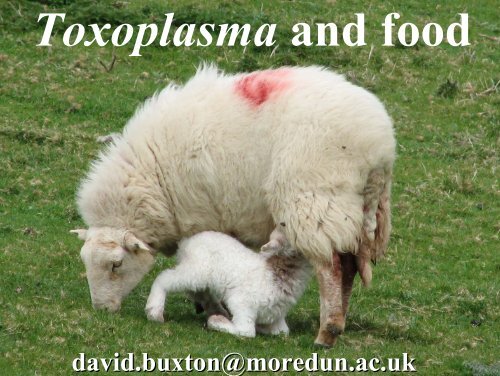
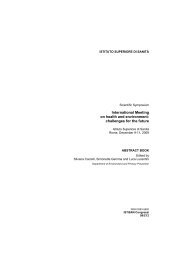
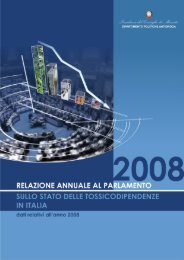
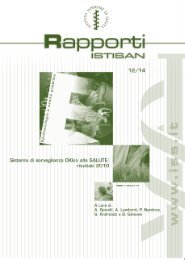
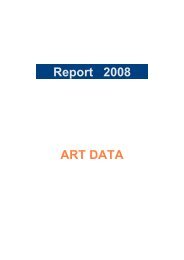
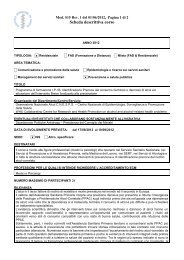
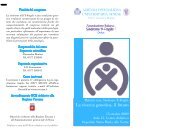
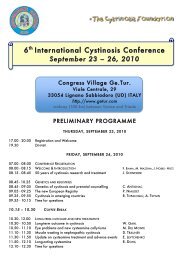
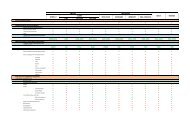
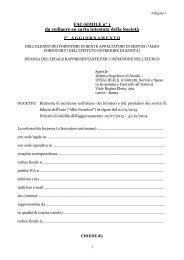
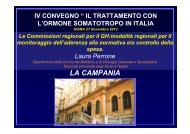
![Emilia Romagna [PDF - 175.10 kbytes]](https://img.yumpu.com/23556597/1/184x260/emilia-romagna-pdf-17510-kbytes.jpg?quality=85)
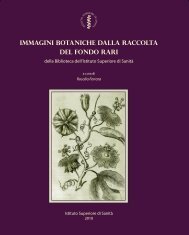
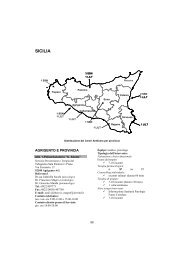
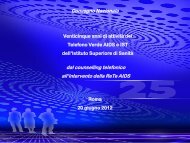
![Istisan Congressi N. 66 (Pag. 1 - 81). [PDF - 2021.12 kbytes] - Istituto ...](https://img.yumpu.com/23556493/1/171x260/istisan-congressi-n-66-pag-1-81-pdf-202112-kbytes-istituto-.jpg?quality=85)